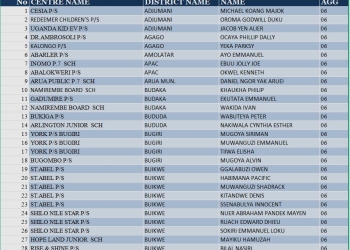
HOIMA, Uganda – The Ugandan cabinet has approved a land policy for the Kabalega Industrial Park, a government initiative aimed at attracting significant investment into the country’s developing oil and gas sector.
Following the policy approval, the Petroleum Authority of Uganda (PAU) organized a tour for prominent Kampala-based business leaders from the Kwagalana Group over the weekend. The tour showcased investment opportunities within the oil-rich Albertine Graben region, spanning the districts of Hoima, Kikuube, Buliisa, and Kakumiro.
Prior to the site visits, PAU Director Ali Ssekatawa provided the delegation with a briefing on the progress of Uganda’s oil and gas projects.
At the Kingfisher development area in Buhuka, Kikuube district, Ssekatawa reported that preparations for Uganda’s first oil production were advancing rapidly.
“We needed 11 oil wells for the first oil, but by this April, we had already drilled 14 and are now working on the 15th,” Ssekatawa said. “The good news for Ugandans is that the oil we anticipated in these wells is present.”
Ssekatawa indicated similar progress at the Tilenga project in Buliisa district, where TotalEnergies Uganda had drilled 125 of the 177 oil wells required for the initial production phase. The Tilenga field is ultimately expected to host 420 oil wells.
“We are confident that by early next year, all wells needed for the first oil will be complete,” Ssekatawa stated.
Kabalega Airport Nears Completion
The business group also toured the Kabalega International Airport, a key infrastructure project for the oil sector valued at over 1.8 trillion shillings.
Ssekatawa said the airport is nearing completion, with only the control tower equipment awaiting installation.
“We’re almost done here. The president will soon commission the airport,” Ssekatawa said. “It will initially handle the transportation of equipment for the refinery’s construction, for which the contract has already been signed. The refinery should be operational within three years.”
He encouraged the visiting businesspeople to view the airport as a future export hub, particularly for agricultural products. Ssekatawa also noted that the government has finalized plans to allocate land within the Kabalega Industrial Park to investors.
“We have begun marketing this opportunity to local investors. We want them to develop facilities such as hotels, bars, schools and more,” Ssekatawa said.
The Kabalega Industrial Park covers approximately 12 square miles, with five square miles designated for the oil refinery. The remaining area is allocated for the airport and other developments.
Highlighting the potential of liquefied petroleum gas (LPG), Ssekatawa said the refinery would produce it in significant quantities.
“Our aim is to reduce reliance on firewood and charcoal and conserve forests. We want our businesspeople to lead the LPG distribution business,” he said.
Crude Oil Pipeline Progress
Regarding the 1,430-kilometer East African Crude Oil Pipeline (EACOP), Ssekatawa reported that 77 kilometers of the pipeline have been delivered to Uganda out of the 296 kilometers needed for the Ugandan section.
“In Tanzania, 1,000 kilometers of pipes have arrived and are being processed. We are optimistic and assure Ugandans that oil will flow,” Ssekatawa said.
While the initial target for first oil was next December, Ssekatawa acknowledged a potential delay of a few months due to the complexity and scale of the work.
“Most of the infrastructure is already on the ground,” he said.
The oil development has currently created 15,000 jobs, with 13,000 held by Ugandans.
“At peak production, we expect to employ about 30,000 people. However, once we transition from construction to production, the required workforce will change,” Ssekatawa said.
Processing Facility Advancing
PAU senior engineer Andrew Ssenabulya said the Kingfisher field, comprising 31 wells, is projected to produce 40,000 barrels of oil per day. Construction of the Central Processing Facility (CPF) is 65% complete.
“By July 2026, we expect the CPF and drilling to be completed. The oil will then be processed and transported to Kabaale in Hoima for further distribution to either the refinery or the pipeline to Tanga,” Ssenabulya said.
To minimize environmental impact, each of the four oil pads at Kingfisher hosts eight wells.
“Excavating more land would damage the environment. Uganda has 6.5 billion barrels of oil, but with current technology and oil prices, we can recover 1.4 billion barrels,” Ssenabulya said. He estimated that at current production rates, it could take 25 years to extract the recoverable reserves.
Ssenabulya noted that 93% of the roads connecting oil pads at Kingfisher are complete, with remaining sections intentionally delayed to prevent damage from heavy equipment transport. Land acquisition challenges have also contributed to delays.
Ronald Kaija of CNOOC Uganda Limited confirmed that 90% of the infrastructure at Kingfisher is complete.
“These are integrated projects. We can’t begin production before EACOP is operational. Although we’re advancing quickly, we must align with the government’s commercialization timeline,” Kaija said.
Business Leaders Urged to Invest
Kwagalana Group chairman Godfrey Kirumira encouraged fellow business leaders to capitalize on the opportunities within the oil sector.
“I already started with an oil testing lab (ICON), but I’ve brought my group to explore further opportunities,” Kirumira said. “It’s time to move beyond arcades and real estate. Oil can transform us like it did for wealthy Nigerians.”
Kirumira commended the government’s efforts to promote local participation and urged businesspeople to act swiftly.
“We’ve seen opportunities in construction, food supply and hospitality. The government is offering us land for industries, and our members have the capital. We just lacked information,” Kirumira said.
Following the tour, Kirumira pledged to share their insights to ensure local investors do not miss out on potential ventures.
To encourage partnerships, PAU hosted a networking dinner in Hoima, connecting business leaders from Kampala and the Bunyoro sub-region. Hoima city mayor Brian Kaboyo called for investment in sectors such as hotels, schools, hospitals, and tourism.
Esther Nakawombe, PAU’s national content officer, outlined key sectors for local participation, including civil works, transport, security, hospitality, food and beverages, ICT, fuel supply, and waste management.
“To access these opportunities, businesspeople must register on the national supplier database,” Nakawombe said, listing requirements such as a certificate of incorporation, tax clearance, Uganda Registration Services Bureau annual returns, and a bank reference.
Nakawombe reported that Ugandan companies have already secured contracts worth 3.9 trillion shillings out of the 25.5 trillion shillings approved to date.
“I encourage Ugandans to apply when tenders are announced and consider joint ventures to meet capacity requirements,” Nakawombe said.

















